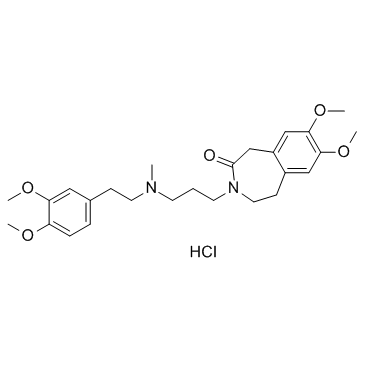盐酸Zatebradine

盐酸Zatebradine结构式

|
常用名 | 盐酸Zatebradine | 英文名 | Zatebradine hydrochloride |
|---|---|---|---|---|
| CAS号 | 91940-87-3 | 分子量 | 493.03500 | |
| 密度 | 1.115g/cm3 | 沸点 | 612.5ºC at 760mmHg | |
| 分子式 | C26H37ClN2O5 | 熔点 | N/A | |
| MSDS | 中文版 美版 | 闪点 | 324.3ºC |
|
Abnormal diastolic currents in ventricular myocytes from spontaneous hypertensive heart failure rats.
Am. J. Physiol. Heart Circ. Physiol. 291(5) , H2192-8, (2006) Hypertension is a common cause of heart failure, and ventricular arrhythmias are a major cause of death in heart failure. The spontaneous hypertension heart failure (SHHF) rat model was used to study altered ventricular electrophysiology in hypertension and h... |
|
|
Effects of tachycardia on regional wall motion in acute ischemic canine heart.
Tohoku J. Exp. Med. 203(2) , 111-21, (2004) Tachycardia accompanies the preload reduction. Our aim is to assess the effect of the heart rate change on wall motion in ischemic heart. In 8 dogs with occlusion of left anterior descending artery, we changed the heart rate (heart rate 90, 120, and 150 beats... |
|
|
Validation of a high-sensitivity assay for zatebradine in dried blood spots of human blood at pg/ml concentrations using HILIC-MS/MS.
Bioanalysis 2(11) , 1863-71, (2010) One of the main reasons for the increased popularity of dried blood spots (DBS) is related to the 3Rs principles (replacement, refinement and reduction) for animal use in drug development. The small blood volume collected using this technique may have a signi... |
|
|
Heart rate reduction by zatebradine reduces infarct size and mortality but promotes remodeling in rats with experimental myocardial infarction.
Am. J. Physiol. Heart Circ. Physiol. 286(4) , H1281-8, (2004) The importance of heart rate for left ventricular remodeling and prognosis after myocardial infarction is not known. We examined the contribution of heart rate reduction by zatebradine, a direct sinus node inhibitor without negative inotropic effects on left ... |
|
|
Blocking effects of acehytisine on pacemaker currents (I(f)) in sinoatrial node cells and human HCN4 channels expressed in Xenopus laevis oocytes.
J. Ethnopharmacol. 139(1) , 42-51, (2012) The root of Aconitum coreanum (Levl.) Raipaics has been extensively used to treat various kinds of disorders including cardiovascular disease in China for a long time. According to recent studies, its antiarrhythmic actions are attributable to the active comp... |
|
|
A pharmacological model for calcium overload-induced tachycardia in isolated rat left atria.
Eur. J. Pharmacol. 576(1-3) , 122-31, (2007) Few experimental models produce spontaneous tachycardia in normal left atria to allow the study of the cellular mechanisms underlying this contributor to atrial fibrillation. We reported 2-aminoethoxydiphenyl borate (2-APB) that provokes sporadic spontaneous ... |
|
|
Design, synthesis and preliminary biological evaluation of zatebradine analogues as potential blockers of the hyperpolarization-activated current.
Bioorg. Med. Chem. 13(4) , 1211-20, (2005) A series of zatebradine analogues, differing in the basic moiety and in the methylene spacer, have been synthesized; their negative chronotropic activity has been determined in guinea pig atria. The most active compounds have been studied for their blocking p... |
|
|
Synthesis and pharmacological evaluation of N-acyl-1,2,3,4-tetrahydroisoquinoline derivatives as novel specific bradycardic agents.
Bioorg. Med. Chem. 12(5) , 871-82, (2004) A series of N-acyl-1,2,3,4-tetrahydroisoquinoline derivatives were synthesized and evaluated for their bradycardic activities in isolated guinea pig right atria and in urethane-anesthetized rats. These efforts resulted in identification of the compound 8a, wh... |
|
|
Three different bradycardic agents, zatebradine, diltiazem and propranolol, distinctly modify heart rate variability and QT-interval variability.
Pharmacology 80(4) , 293-303, (2007) Zatebradine, diltiazem and propranolol are all antiarrhythmic agents, and all induce bradycardia, but each is known to have a different initial molecular mechanism: zatebradine is a channel blocker of the hyperpolarization-activated inward current (I(f)); dil... |
|
|
The impact of organic inhibitors of the hyperpolarization activated current (Ih) on the electroretinogram (ERG) of rodents.
Arch. Ital. Biol. 142(2) , 95-103, (2004) We have compared the effect of two distinct Ih inhibitors on the temporal properties of the ERG response that, as previously shown, correlates well with the HCN activation in rods. The present results confirm the notion that cilobradine is more effective than... |